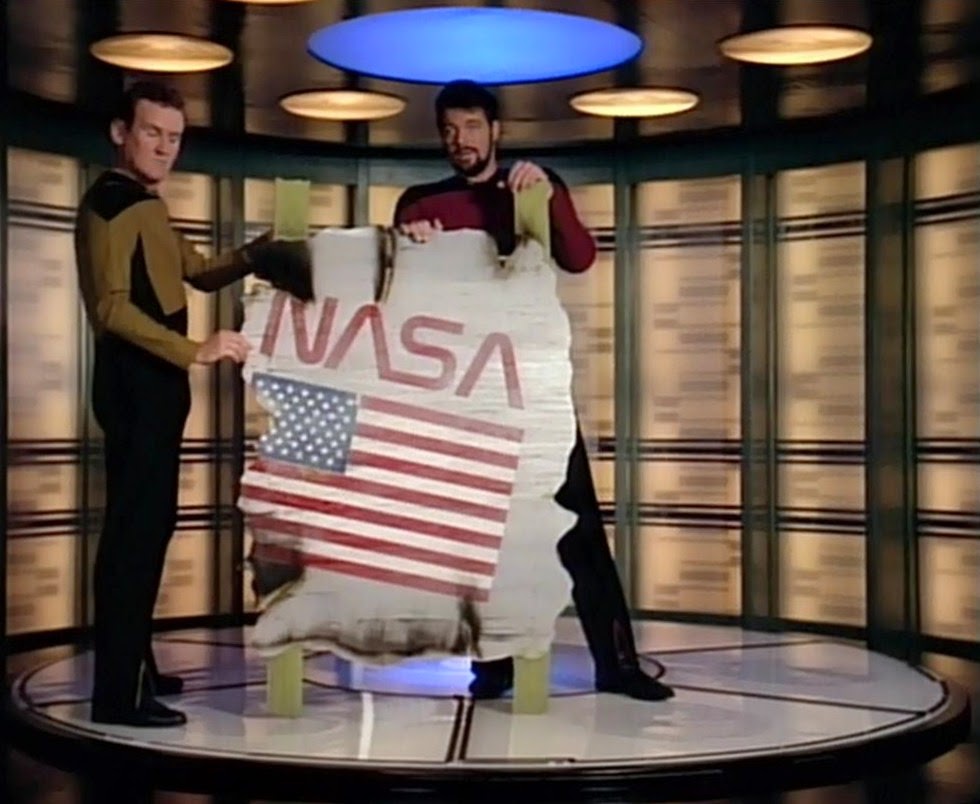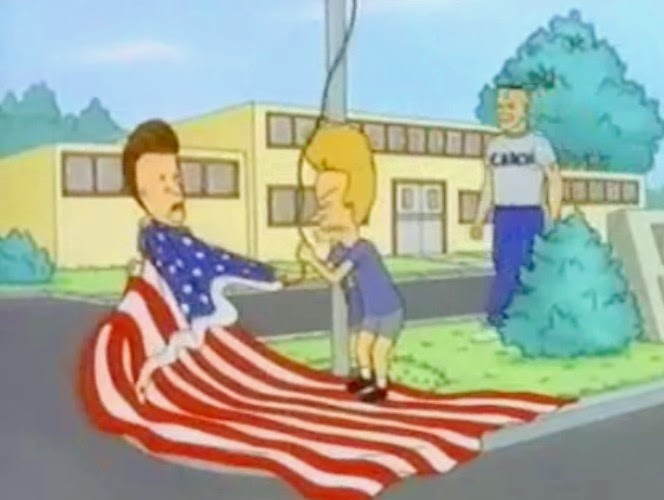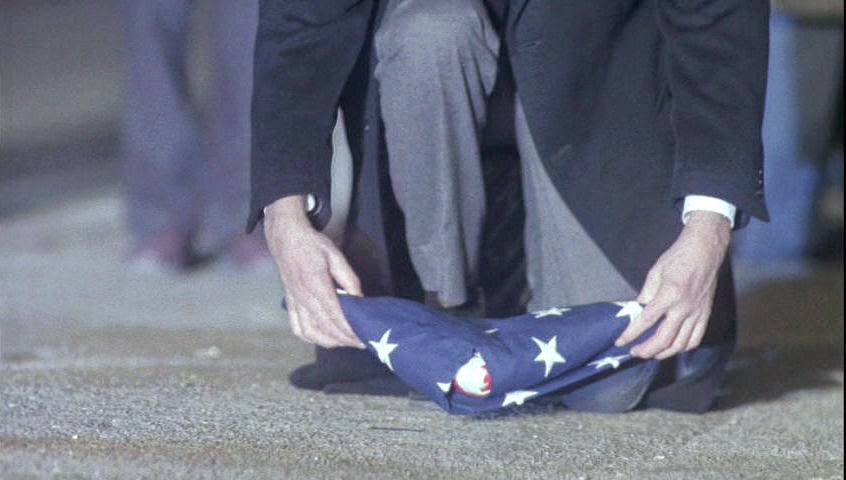“In the vast immensities of cosmic space, bold adventurers streak their way to join battle with strange enemies on strange worlds: the alien, the unknown, perhaps even the invisible, armed only with Man's earthbound knowledge...”
- The Control Voice narration to “The Invisible Enemy” on The Outer Limits (1964).
Earlier in the week, I wrote about “The Invisible Enemy,” an episode of the science-fiction/horror anthology The Outer Limits (1963 – 1965).
I described it as being part of a favorite sub-genre: the failed outer space expedition.
In stories of this type, courageous astronauts brave the dangers of the void in their rockets and spaceships, and discover not wonders of nature…but the very horrors of Hell itself.
Films have visited this trope in such efforts as Alien (1979), and the recent Europa Report (2013), but this list focuses on TV instead, a realm where the failed space expedition trope has seen many iterations.
Many cult-television series are actually predicated on the concept of a “failed” space expedition, from Lost in Space (1965 – 1968) and The Starlost (1973 – 1974), to Planet of the Apes (1974 – 1975), Buck Rogers in the 25th Century (1979 – 1981) and Farscape (1999 – 2003).
Not all those series, however, tread in the terrain of pure terror: the unexpected conjunction of amazing high technology with Gothic “monsters” in an arena that should be reasonable, scientific, and wondrous…but determinedly isn’t. Highly-trained and resourceful astronauts in these episodes suddenly find themselves confronting things that shouldn't exist at all; things like ghosts, dragons, and vampires.
Other TV series (not featured below) offer variations on the formula, but don’t necessarily focus on spaceships: Doctor Who’s “The Waters of Mars,” for instance, concerns a base on Mars that falls to an implacable alien horror called “The Flood.”
In terms of categorization, a good “failed space expedition” story not only terrifies, it sets up a high level of danger for those who discover the expedition's aftermath, and must tread (warily…) in its footsteps.
So without further introduction, here are my selections for the five most horrific failed space expeditions in cult-television history.
To be included on my list, the mission must end in abject failure, and with lots and lots of death and destruction. These are my choices, but no doubts others will choose other episodes.
5.The final journey of the U.S.S. Essex (“Power Play,” Star Trek: The Next Generation [1992]):
Nearly 200 years before the days of NCC-1701-D, a Daedalus class starship called U.S.S. Essex, encounters terror on Mab-Bu IV and is never heard from again.
When the Enterprise answers its distress call two centuries later, the captain of the Essex and his top crew are reportedly alive, albeit in a strange form. They “survive” as disembodied “ghosts” inside a planet-wide storm.
The truth is much more bizarre, however. The planet is actually a penal colony containing the Ux-Mal’s most monstrous (but non-corporeal) criminals. The Essex captain and his ship died generations ago, when the prisoners seized the ship, and it failed to escape the planet’s gravity well.
This is one of my all-time favorite Next Generation episodes because it boasts no preachy messages, and the Enterprise crew spends the hour trying to figure out exactly whom it is dealing with when Troi, Data, and O’Brien are apparently possessed by the Essex’s command crew.
But in terms of the failed space mission premise, I love “Power Play” because it points out the danger of space travel in early Starfleet history. Here, a starship “boldly went where non had gone” and encountered new life forms of a most malicious variety. Star Trek isn't a universe where one expects to find "ghosts," but that's a good term for the merciless aliens Picard combats here. This episode also offers one of the few instances in the series when it is possible to resolve a situation by peaceful diplomacy, and talking to an enemy.
In the year 2021, the M-1 rocket lands successfully on Mars. But this giant step for space exploration ends in terror, when the first astronaut on the Martian surface screams in terror, and then disappears without a trace. The second astronaut heads out to the surface, and meets the same mysterious fate.
Six years later, the crew of the M-2 discovers the grisly disposition of those unlucky men. They encountered dragon-like shark creatures that “swim” the sandy terrain of the red planet. Now, the four-man crew of the M2 is similarly imperiled by the over-sized, carnivorous beasts.
This episode of the classic anthology series plays adeptly on the fear that something might exist beneath our very feet, something that could pull us down into the very ground itself, and destroy us. And the episode’s final revelation -- of a whole school of the sand-sharks laying in wait -- is unforgettable in terms of its imagery.
Here there be dragons...
3. The bizarre fate of the E-89 (“Death Ship,” The Twilight Zone [1961])
This mysterious and unsettling story from the late Richard Matheson occurs in the year 1997, as three astronauts -- Captain Ross (Jack Klugman), Lt. Mason (Ross Martin), and Lt. Carter (Frederic Beir) -- visit a distant planet and are afforded an unwelcome glimpse of their own future.
On the surface of the planet is a wreckage of a spaceship…their spaceship. Captain Ross believes that they have somehow "circumnavigated" time and arrived on the planet in their own near future, perhaps as the result of a time warp.
Now the question remains, how does the ship’s crew avoid a future in which it is fated to die?
Unlike the other stories on this list, “Death Ship” involves no overt “monster.” There are no sand sharks, ghosts, vampires or other creatures to contend with. Instead the crew’s nemesis is time itself, and perhaps that is an even scarier enemy. As I wrote in my review of the episode, "Death Ship" is a great story because it arrives at its shocking ending side-ways.
The episode features all the trappings of futuristic science fiction drama, with discussions of time travel and alien life, but as is so often the case on The Twilight Zone (and in the work of Richard Matheson) the resolution of the enigma involves the very nature of man; the metaphysical not the technological.
In crafting a tale of a protagonist and captain who sees what he wants to see, and the men who follow him in that (tunnel) vision, Matheson's "Death Ship" takes the mysteries of outer space and links them right back to the essential nature of humanity, right here on Earth. For a time it looks like the story is about "fear -- the "death fear" as one character describes it -- but the tale actually involves the acceptance of the unacceptable in our lives...and in our deaths.
This is one of the darker corners of The Twilight Zone, no doubt.
2. The last voyage of the I.S. Demeter (“Space Vampire” Buck Rogers in the 25th Century [1980])
An unknown presence -- believed to be the “Denebian virus” or “EL7” -- begins to kill the passengers and crew of the I.S. Demeter in “Space Vampire.”
Although the last survivors hold out hope that they can reach their destination alive, it is not to be. All hands have perished by the time the vessel passes through Stargate Nine and reaches Theta Station. Their murderer is a strange vampiric entity called a Vorvon, known in legends for “draining the souls” of the living.
On Theta Station, Buck (Gil Gerard) watches the Demeter’s captain’s log, and realizes the horror that now lurks on the station.
The Demeter is named after the ship that transports the un-dead count to England in Bram Stoker’s Dracula, and serves much the same purpose in this entry of the 1979-1981 series: setting the stage for the next appearance (and escalation) of a terrifying entity.
Where most episodes of Buck Rogers are light-hearted and breezy (and quite enjoyble so...), an atmosphere of absolute gloom and dread hangs over "Space Vampire," especially the sections involving the Demeter. There is an air of ghastly inevitably here as the captain reports death after death, until the Vorvon finally comes for her...
It is impossible for me to measure how deeply or profoundly this episode of Space:1999 impacted my psyche when I first saw it as a young lad (at the tender age of five). I suspect, in fact, that “Dragon’s Domain” is the very production that catalyzed my life-long love of horror and science fiction.
“Dragon’s Domain,” by Christopher Penfold, depicts the tragedy of the ill-fated Ultra Probe, which began its weeks-long voyage to the newly-discovered planet, Ultra, in the year 1996.
In orbit of the planet, however, the astronaut crew discovers a mysterious “parking lot” of alien spaceships. When docking with one such mystery ship, however, something...alien...gets inside the Ultra Probe (commanded by Tony Cellini), something horrible.
That horrible thing is a tentacled, slimy nightmare that can hypnotize the living, and...then devour them. But even that isn’t the end of the terror. After eating the crew, this monster spits out the corpses’ steaming bones from its orange-hot maw.
The resulting image: a smoldering skeleton on a high-tech spaceship deck, is one that has remained with me my whole life, and captures perfectly the magic of the “failed space expedition story.”
You look at that image (below..) and wonder, how in the cosmos can this happen? How can mankind achieve his highest aspiration -- the stars themselves – and end up like this? Merely charred food for something unimaginably horrific, unimaginably monstrous?
In the course of “Dragon’s Domain,” Tony Cellini gets a second chance to face his monster, and even when fully seen for a second bout, the creature loses none of his ghastly power. The creature squirms, wriggles, shoots out fluid (ick…) before consuming its final victim. In the end, the truth is that the parking lot of spaceships was a spider's web, and that this monster was the spider itself.
The story ends with a final, frightful thought to carry with you into your nightly slumber. If the astronauts never determined, via their advanced scientific instruments, that the creature was alive... how could anyone be sure that it was really dead?
Alas, fans of failed space expeditions never got the TV sequel to "Dragon's Domain" that this chilling ending so perfectly set-up.
Other contenders for this list include "The Satan Pit," a Doctor Who story in which a team of space miners (again operating from a base, not a ship) excavate a "Beast" that is, in fact, the Devil, and "Planet of Evil," another Doctor Who story set at the edge of the known universe, and featuring an anti-matter universe.




































































